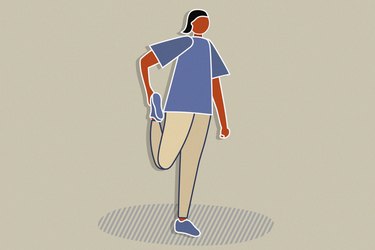
Let's be honest: A warm-up is like the opening act before the main show — it's often skipped.
Whether you doubt its benefits (are a few toe touches really going to help me squat better?) or you've got somewhere to be, you might be wondering just how big of a deal it is not to spend a few minutes doing some body-weight lunges before running a few miles on the treadmill.
Video of the Day
You Could Get Hurt
You may have dodged an injury today, but consistently skipping a warm-up means a muscle strain or other injury could be brewing.
"You're taking a big risk of getting injured if you don't take just 10 minutes to warm up before you work out," Latreal Mitchell, celebrity trainer and EBOOST fitness expert, tells LIVESTRONG.com. "Sometimes an injury will set you back for weeks, so not spending a few minutes warming up before a workout is just not worth it," she says.
In fact, one of the major causes of acute muscle strains is improper loading of the joint and muscles when performing a heavy lift, according to the Mayo Clinic. But when you do a warm-up before exercise, you're conditioning your body to load the right muscles and follow movement patterns that help prevent injury.
For example, when you're warming up to perform deadlifts, you want to practice the hinge movement first, with a move like the good morning exercise, which trains you to properly load the your hips, butt, core and back.
Instead of stalling your hard-earned gains with an injury, warm up for as little as five to 10 minutes before your workout to help prevent damage down the road, according to the American Council on Exercise (ACE).
Your Performance Might Suffer
Warming up your muscles before diving into a workout helps increase the body's core and muscle temperature, says chiropractor R. Alexandra Duma, Team USA's sports chiropractor, of New York City's recovery and wellness studio FICS.
"Think of a warm-up the same way that you think of your car warming up on a cold wintery day — it just performs better," Duma says. When your muscles' temperature increases, your joints become more flexible, improving your body's range of motion.
But don't just go through the motions: Research suggests that working hard at your warm-up can help your performance when it comes to the main event. (Read: You'll squat deeper and lift more weight overhead.). Per a July 2015 systematic review in the British Journal of Sports Medicine, a high-load, dynamic, warm-up can help enhance power and strength.
What Should Your Warm-Up Look Like?

There isn't a one-size-fits-all warm-up routine because the exercises in your warm-up largely depend on the type of movements you're going to be doing in your workout.
For example, if you're preparing for a long run, you would focus mostly on warming up your lower-body muscles and core. But if you're prepping to do some shoulder presses and pull-ups, then you would do exercises that activate your upper-body muscles.
However, research shows that doing a dynamic warm-up trumps static stretching when it comes to providing benefits before exercise.
An April 2012 study in the Journal of Strength and Conditioning Research, which compared the effects of a dynamic warm-up and static stretching on quadriceps strength and hamstring flexibility, found that a dynamic warm-up was more beneficial than static stretching, which didn't provide any changes.
Moreover, a June 2019 study in the European Journal of Applied Physiology suggests that static stretching alone — without a dynamic warm-up — can have negative effects on muscle performance.
Dynamic stretching is active and involves moving your muscles and joints around to stretch and get your heart rate up. Static stretching, on the other hand, involves holding a position for an extended period of time to lengthen and relax the muscles. While both types of stretching can lengthen muscles, static stretching doesn't warm up your joints, muscles and nervous system the way that a dynamic warm-up can.
Tip
Save static stretching for your post-workout cooldown.
How Long Should You Spend Warming Up?
Duma recommends keeping your warm-ups low-to-moderate intensity. You don't want to be completely taxed and breathless, but you want to get your heart rate up enough that you might break a light sweat. Aim to do each warm-up exercise for 30 seconds, or 8 to 10 reps, for 2 to 3 sets, according to the ACE.
Too much energy expenditure during pre-workout movements can result in your body overheating too quickly, which could hurt your performance. "The saying 'less is more' applies in this case," Duma says. "Warm-ups should help you feel good and get you to break a sweat."
Try This 5-Minute Dynamic Warm-Up
For another warm-up routine that helps get the body moving, try this quick circuit from Duma. Perform each exercise for 30 seconds for 2 to 3 sets.
Move 1: Body-Weight Squat
- Start standing, feet hip-width apart.
- Extend your arms out in front of you and slowly bend your knees as you push your hips back to squat down. Focus on lowering your body as if you were going to sit on a chair.
- Squat down until your thighs are parallel with the floor, or as low as you can go comfortably while maintaining good form. Your knees should be over your toes and your gaze should be straight ahead.
- Pause for a moment at the bottom of your squat.
- On an exhale, reverse the motion by pressing through your heels to return to standing. As you stand, lower your arms back to your sides.
Move 2: High Knees
- Stand with your feet hip-width apart.
- Drive your right knee toward your chest and quickly place it back on the ground.
- Follow it immediately by driving your left knee toward your chest.
- Continue to alternate knees as quickly as you can.
Move 3: Jumping Jack
- Start standing with a slight bend in your knees, feet together, arms by your sides.
- Simultaneously jump both feet apart and swing your arms out to the sides, then up overhead.
- Hop both feet together and swing your arms back down to the starting position.
Move 4: Jump Rope
- Stand with your feet together, holding one end of the jump rope in each hand with the rope behind you. (Pretend you're jumping with an imaginary rope if you don't have one.)
- Keeping your elbows close to your sides, swing the rope with your wrists up over your head and allow it to fall toward your feet.
- Jump up with both feet before the rope hits your feet and repeat.
So, How Bad Is It Really to Skip Warming Up?
The truth is that it's never a good idea to skip a warm-up. Whether you're lifting, doing HIIT or running, you should warm up, regardless of how long your workout actually is. When you make time to warm up, you decrease your chances of injury and allow your body to adjust to the demands of your workout.
What your warm-up looks like and how long it is will depend on the type of workout you're doing. But generally speaking, a warm-up should last anywhere from five to 10 minutes, and it should include dynamic exercises that get your heart rate up and your joints moving.
To find the right warm-up for you, consider working with a personal trainer who can prepare a routine that fits your needs.
Related Reading
Additional reporting by Tiffany Ayuda
- Mayo Clinic: "Muscle Strains"
- American Council on Exercise: "5 Reasons Movement Preparation Is an Effective Warm-Up Strategy"
- British Journal of Sports Medicine: "A Systematic Review of the Effects of Upper Body Warm-Up on Performance and Injury"
- Journal of Strength and Conditioning Research: "A Dynamic Warm-up Model Increases Quadriceps Strength and Hamstring Flexibility"
- European Journal of Applied Physiology: "Unilateral Hamstrings Static Stretching Can Impair the Affected and Contralateral Knee Extension Force But Improve Unilateral Drop Jump Height"
- American Council on Exercise: "What's the Deal With Prehab?"
